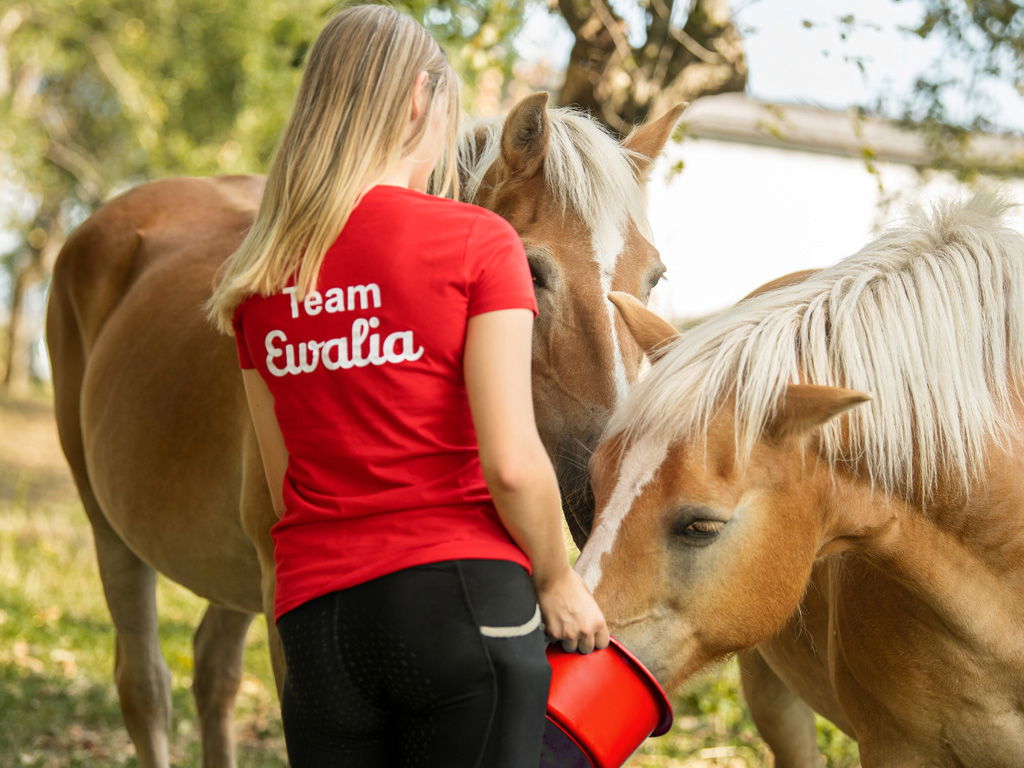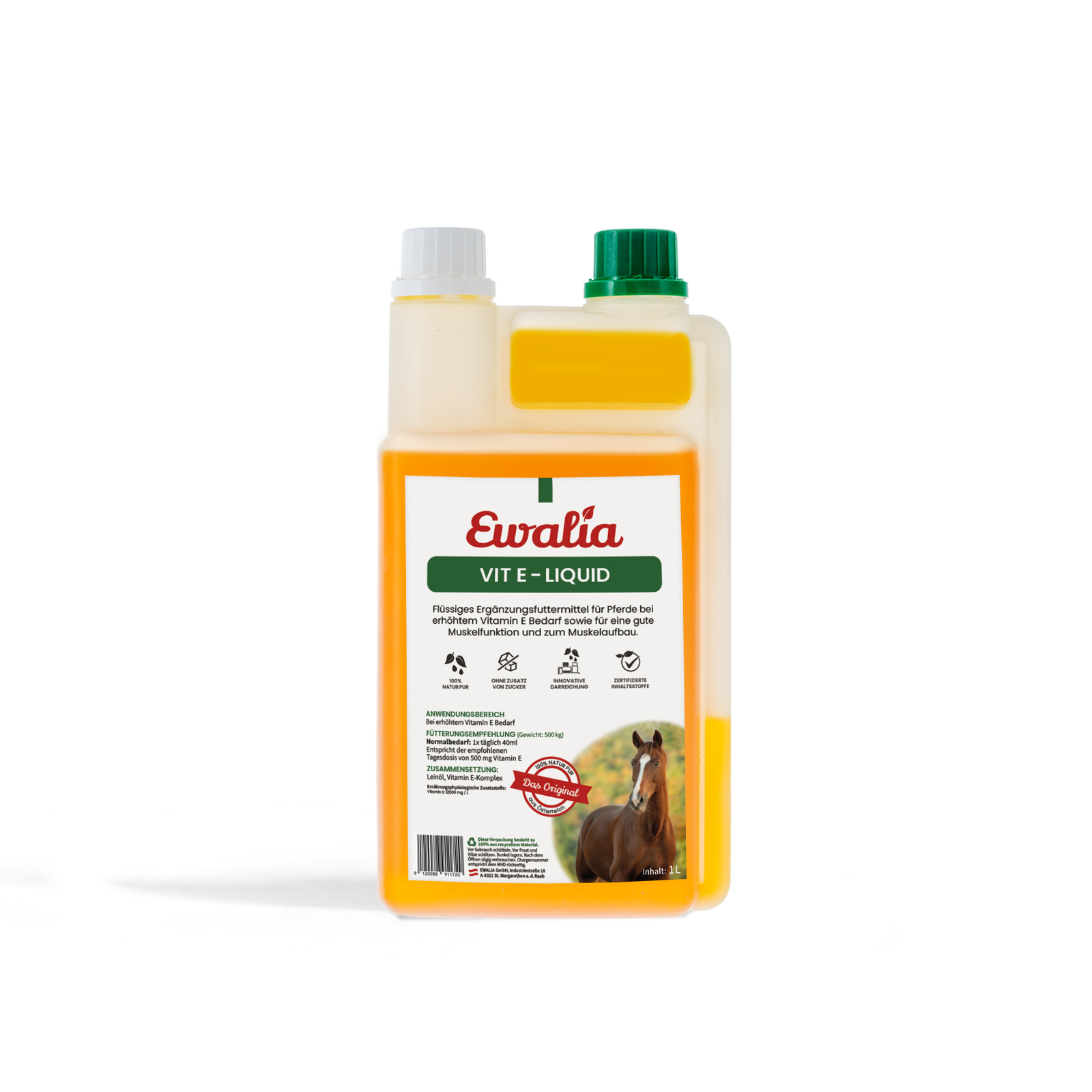Selenmangel beim Pferd

What is selenium and why is it essential for my horse?
Selenium is a macroelement which a horse’s body needs, but which it cannot produce itself. It must be absorbed from feed. Selenium is not an antioxidant (as often described), but an “oxide stopper”, meaning that it renders the oxidation property of a substance inactive. Hydrogen peroxide is a toxic substance that can be rendered harmless or inactivated by the coenzyme selenocysteine. Too little or no selenocysteine can lead to hydrogen peroxide destroying erythrocytes (red blood cells). Selenium is also essential for the immune system, raises the body’s natural defences and ensures the desired immune system reaction following inoculations.
How much selenium does my horse need?
Horses need about 0.2 mg of selenium per 100 kg of body mass. Increased requirements due to factors such as performance, pregnancy etc. are not included here. According to the medical literature, the toxic value amounts to over 5 mg per day for an average body weight of 600 kg. In itself, however, the requirement fluctuates not only with performance, but also for example with the intake of unsaturated fatty acids.
When feeding larger amounts of unsaturated fatty acids such as linseed oil (e.g. 100-200 ml oil), fish oil (generally not recommended for horses) or fatty grasses, which are often found in Austria, the horse's selenium increases significantly, as does its vitamin E requirement.
What is the connection between vitamin E and selenium?
Vitamin E and selenium are closely linked to one another, as selenium cannot do its work without vitamin E. It needs vitamin E to be useful to the horse’s body. This could, for example, be reflected in very high selenium serum levels, showing not an excess of selenium but actually a serious deficiency of vitamin E. Horses with massive vitamin E deficiencies often appear rigid or display sudden muscle cramps. The supplementation of magnesium in high doses does not appear to improve the conditions of afflicted horses. It is therefore always worth taking a look at the total ration so as not to overlook possible deficiencies.
What determines the amount of selenium in base feed?
The amount of selenium in base feed depends on the soil. Measurements of average selenium values in soils point to a European north-south divide. The further north one goes, the richer the selenium content, and vice versa. Short-term, local influence through fertilisation is possible, however. If a group of horses is fed a large amount of selenium and their excrement is left lying in the pasture, this abundance of selenium will make its way into the soil and consequently into the grass. Theoretically, this could eventually poison the horses. A possible mineral fertilisation of the soil can be identified in advance through hay analyses of the forage, and the mineral requirements adjusted accordingly.
How do I recognise if my horse has a selenium deficiency or selenium toxicity?
A horse with a severe selenium deficiency will appear tired and listless, and its muscles will be hard and stiff. It may suffer from loss of coat and a drop in performance. Some horses with selenium deficiencies suffer from excessive arousal.
A horse with an excess of selenium, i.e. with chronic selenium toxicity, will show symptoms such as ring-shaped constrictions on the hooves, rupture of the hoof capsule (laminitis), loss of coat in the mane and tail, and unspecific lameness. The signs of an acute selenium toxicity are severe colics and profuse sweating.
Consult your veterinary surgeon if you suspect that your horse has a selenium deficiency/excess!
How does selenium toxicity occur?
With selenium supplements, the chemical structure and the manufacture of the product are of particular interest. In nature, selenium is found as a purely inorganic (semi-metal) substance in plants such as linseed, grass and sunflower seeds. The sodium selenite used in most mineral preparations and feedstuffs is present in an inorganic state.
In contrast, selenium yeast (selenomethionine, selenocysteine, selenocystine) is not produced naturally, but is genetically engineered. Selenium yeast is made by adding selenium to yeast cultures, so that it can be made available to the horse in an organic state. This significantly increases the resorption capacity, however an excess of selenium cannot be eliminated; rather, it is usually incorporated in the formation of tissue in place of zinc. This is not a problem until the moment when the tissue suddenly starts to break down, which can lead to spontaneous toxic reactions, as horses have a very low selenium tolerance.
An excessive dose of the inorganic sodium selenite is eliminated through the intestine, therefore caution is advised when using selenium yeast!
What do I need to be aware of when feeding my horse selenium?
It is important to consider the overall picture. Low selenium levels in blood serum do not necessarily mean that your horse needs to be fed selenium. Every horse has its own individual selenium requirement. If your horse’s blood analysis indicates a low selenium level, but your horse is obviously doing well with no skin or hoof issues, you can take a look at how much selenium is already being provided. Find the selenium contents in your horse’s mineral feed and forage, and calculate roughly how much it is getting. Look also at your horse’s intake of vitamin E and vegetable oils, which could increase its need for selenium. If selenium intake is roughly in line with requirements and your horse is fit, no urgent action is required. If, however, the level is very high or very low and your horse does not seem healthy or perhaps even shows signs of a slight deficiency, then it is best to consult your vet about your next steps.
Which feeds contain naturally higher levels of selenium?
No general values can be given here as selenium levels in forage fluctuate depending on the soil and fertilisation. One may assume a low amount of selenium in the forage grown on acidic soils such as residual soils of weather granite, sand, or moorland. Highly concentrated fertiliser may raise this amount to a level higher than expected. It is recommended that the amount of selenium that the horse absorbs from its base feed be determined through a hay analysis and adjusted through rationing.
Natural sources of selenium in crib feed include linseed and rapeseed as well as by-products like linseed cake, obtained through oil extraction. Drying at high temperatures reduces the amount of selenium in the feed, as this leads to the formation of volatile hydrogen selenides which then evaporate.
The selenium content in linseeds fluctuates, according to processing, between 0.1 and 1 mg/kg dry mass. Through the concentrated form after pressing and processing, the content in linseed cake is clearly higher than in unprocessed linseed. Brewer yeast and wheat bran should also be mentioned here, as their measurements indicate a higher average selenium content of 0.40 to 0.71 mg/kg dry mass. Special attention should be paid if these feeds are combined with a high-dose selenium preparation or mineral feed. Do not exceed the horse’s daily requirement.
In short:
· Selenium is an “oxide stopper”
· Horses need 0.2 mg per 100 kg of body mass
· Selenium needs vitamin E
· An excess of selenium in the blood may indicate a vitamin E deficiency
· Not all soils are poor in selenium
· Local fertilisation may influence the selenium levels in the base feed
· Inorganic selenium (sodium selenite) is preferred for supplemental feeds
· The horse’s body cannot eliminate an excess of selenium yeast
· Take a look at all the feeds your horse is given to compare the total amount of selenium provided with your horse’s requirements.
Author: Bianca Becker-Slovacek, 25/03/2020
Citations and bibliography
Coenen, M., & Vervuert, I. (2020). Pferdefütterung (6. Ausg.). Stuttgart: Georg Theme Verlag KG.
Gerber, V., Venner, M., & Straub, R. (2016). Pferdekrankheiten: Innere Medizin (2. Auflage Ausg.). (V. Gerber, & R. Straub, Hrsg.) Bern: utb.
Röhm, C. (2019). Nährstofflehre in der Pferdefütterung. Webinar. Unabhängige Fütterungsberatung Constanze Röhm.















